 6
6




 31. 07. 2023
31. 07. 2023

The BBC Documentary has made an almost hour-long documentary about Egypt focusing on the Sphinx of Giza. The documentary will mainly feature Mark Lehner and his longtime friend Zahi Hawass.
Contemporary Egyptian stonemason (21: 00) Fatuj Mohamed demonstrates how very difficult to move even relatively small stones and then process them.
He complains that he fears that his iron tools will soon be destroyed by working the stone. Therefore, everyone wonders how the Egyptians could have done it without modern iron tools.
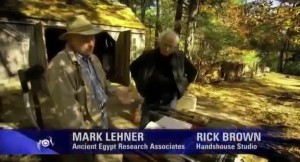
Egyptologist Mark Lehner and historical instrument expert Rick Brown decided (21:58) to reconstruct the Sphinx's nose in a 1: 2 scale.
They relied on archaeological finds in the tombs and their murals that the Egyptians used exclusively copper tools and stone hammers.
In order for the reconstruction to be as authentic as possible, they decided to make the instruments directly for television (22:55). The document will make it clear that: much earlier than if harder bronze and iron were invented, the Sphynx builders used copper tools. According to Brown, the copper was heated in a fire, shaped with a stone hammer (sphere).
The resulting tool (in this case a chisel) was allowed to cool. The production of one chisel according to the film footage took at least 3 minutes. The future chisel had to be heated repeatedly so that it could be shaped into a tip (the shape of a pointed pyramid).
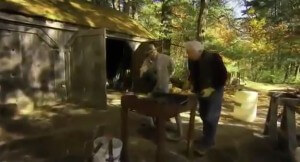
I wonder if it was common in the time of Egypt to use the coal used by the protagonists of the experiment. Mark Lehner's comment shows that they used wood.
At 25:00 we will learn that another key tool was a stone hammer mounted on two sticks tied in the shape of the letter V.
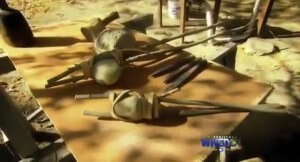
The Sphinx's nose is said to have been shot down by Napoleon's army when the Sphinx served as a training target for artillery. According to period drawings, the Sphinx's nose was already damaged in Napoleon's time. Two scratches in the area of the nose offer the idea that the nose was cut off long ago.
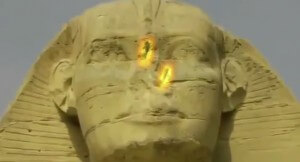
And here we go (27:00) using primitive tools, both actors are getting ready for a new nose.
Within 15 seconds of the film, they come to the conclusion that it is a really strenuous thing. Basically, they have no significant progress and the tip of the copper chisel bent 5 ° after about 45 blows and blunted - the chisel was unusable.
The use of stone sticks was absolutely effective. The commentator says that for several hours they were tired to death (and someone came to their aid - they worked in threes).
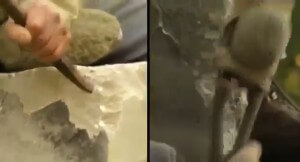
The documentary filmmakers used the magic of editing and decided to divert attention from the fiasco elsewhere. He does not return to the nose reconstruction until 31:33. After many days of work, copper chisels and stone hammers were completely unusable. In the time of 31:50, all authenticity will take over and modern technology will start - a cutting machine, contemporary iron chisels and a jackhammer.
Brown defends the situation: We tried to use ancient Egyptian instruments for a long time, and then we decided to use modern tools to accelerate our work. Although modern tools accelerated the work, no drastic progress was made. The commentator states that even with modern tools, machining such a hard stone is a difficult and time-consuming thing.
Mark Lehner calculated that the jackhammer strikes approximately 33 times per second. On the other hand, with a copper chisel it is possible to make a few strokes per minute. Brown states that the copper chisel is completely unusable after cutting off about 10 centimeters of material (it is bent and blunt). Thus, a flame welder comes into play, which the authors of the experiment accelerate the straightening of the copper chisel to the required state.
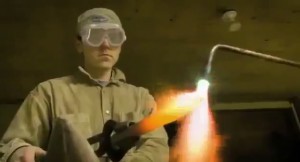
Brown clarifies (33:00) that the copper chisels had to be repeatedly worked in fire to obtain the desired shape. The chisel bends again very quickly.
Brown explains (33:30) that the copper chisels dull very quickly, so they decided to move the hearth closer to the unfinished nose. We try to speed up the process of heating, shaping and cooling the chisel in the required shape, which, according to Brown, is probably the right way to do it in ancient times.
Even after many days, only a small process can be seen on the stone. It is very difficult to imagine that the crooked stone could sometimes be a nose, even half the size of reality. It is even harder to imagine that the whole Sphinx, which is about the size of a football field, would be processed in a similar way.
Again, attention is diverted. For several tens of minutes, the documentary deals with the question of which Pharaoh Sphinx built and what face is depicted on the statue. In this part, it is worth mentioning the 47th minute, when Mark Lehner commits astronomical correlations. It gives the impression that he was quietly inspired by people like Robert Bauval, Graham Hancock and John A. West.
The nose is back in play at 49:00. The nose is completely finished.
Rick Brown demonstrates finishing work for cameras using copper tools and contemporary wooden sticks. It can be seen that everything is more for the film effect. The nose is professionally processed. Not much is said in the document about how many professional stonemasons and how many modern techniques were used.
Mark Lehner comes to the scene and asks the audience: Guys, does it seem to have taken 2 for weeks?
Brown: Yeah, in two weeks. We worked every day.
Lehner: It looks like a great nasal job. - I'd like to know how long it took to make this nose, because we can deduce from it how long it took to cut out the whole Sphinx.
Commentator: Though they chose to use modern technology to speed up their work, they decided to count how long it would take if they used historical tools.
Brown: We counted that we were able to make 200 strokes for 5 minutes = 0,67 strokes per second. One of the stonemasons took 40 hours to cut the 0,028 m3 material.
Commentator: After long calculations and a lot of mathematics, they came to the conclusion that…
Lehner: Consider 100 Workers and 1 Million Hours of Work.
Brown: This means 100 workers would do it for 3 years.
Commentator: According to Brown and Lehner, an army of people had to be employed to build and sharpen instruments (including repeated instrument renewal), material transport, timber delivery, hammer making, and ...
Brown: ... so the ancient people built the pyramids and the Sphing. (Conclusion as from a fairy tale.)
The documentary continues (51:47) with a general summary of Giza history from the point of view of official Egyptology.
I do not know what the authors of this document intended, but the title of this article comes to me as a witty story: "The Sphinx has shown a long nose to the Egyptians." The document very elegantly shows that the efficient use of copper tools for the practical working of stone on Sphinx and / or Pyramid buildings on the Giza Plateau is practically excluded.
The mathematical conclusions at the end of the document are so mysterious (and especially exaggerated) that they are far from practical applicability. For example, if we stick to Brown's theory that you need a new tool every 10 minutes, that means you need a new chisel after 400 strokes. However, the mentioned 10 minutes are very exaggerated, because it is clear in several shots that the chisel bends after about 5-10 blows. Brown tries to get around this by turning the chisel to start bending in the opposite direction. However, this will not prevent the fact from becoming completely dull after another 10 strokes.
So we have a copper tool that can withstand 20-50 strikes. With Borwn's stated 0,67 hit / second speed, an experienced stonemason 1 to 2 chisels per minute needs! Let's imagine a huge manufactory that would have something like that ... megalomania's consumption of wood and human strength.
Their calculations are based on extrapolation only, because they themselves were unable to complete the project using the methods they attributed to the ancient Egyptians.